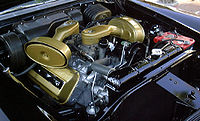
Photo from wikipedia
Optically accessible engines are an essential tool to investigate the combustion process in internal combustion engines via optical and laser optical methods. These methods can be applied to analyze the… Click to show full abstract
Optically accessible engines are an essential tool to investigate the combustion process in internal combustion engines via optical and laser optical methods. These methods can be applied to analyze the mixing formation, injection, combustion, and emission formation in situ for a better understanding of the combustion process. The derived findings result in new potentials for increased efficiency and reduced emissions. While the application for passenger car- and truck-size engines is quite common, the application of such an optically accessible engine is rather rare for large-bore engines driving ships or power plants due to their huge scale. The following sections show a conceptual design study to make a large-bore dual-fuel (DF) engine with a bore of 350 mm and stroke of 440 mm fully optically accessible according to the Bowditch principle. As the layout was based on an already existing and working engine of the same principle but half the bore, numerical investigations of the critical parts of the presented large-scale fully optical engine were carried out to consolidate the feasibility of the design study. On the other hand, the study emphasizes the extremely high efforts necessary to build a fully optical engine of this size. Two alternatives to the engine design study of the Bowditch fully optically accessible engine are presented with the advantage of reduced design effort. The first alternative uses a special modified con rod limiting the construction effort of the engine, but the possible observable field of view is quite limited. A second alternative mounts a wide-angle optic in the center of the cylinder head to realize the Bowditch typical horizontal view from the top instead of from the bottom. Comparing these conceptual designs, the wide-angle optic mounted in the cylinder head of alternative 2 presents the most promising approach to build a large-scale fully optically accessible engine with relatively low effort, offering maximum field of view and characteristics comparable to a fully optical engine concerning bearable engine load.
Journal Title: SAE International Journal of Engines
Year Published: 2019
Link to full text (if available)
Share on Social Media: Sign Up to like & get
recommendations!